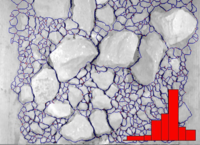Grain size

Okay kiddo, imagine you have a bag of sand. Inside that bag, there are millions and millions of tiny grains of sand. Now, those tiny grains of sand can be different sizes, some are big and some are small. That's what we call grain size.
Grain size is the size of the tiny particles that make up a material, like sand or rocks. When we talk about grain size, we usually mean the size of the particles that are visible to the naked eye. For example, if you look at a piece of sandstone with your eyes, you might see lots of tiny little particles. The size of those particles is the grain size of the sandstone.
When scientists study different materials, they look at the grain size because it tells us a lot about the material's properties. For example, materials with smaller grain sizes are usually stronger and harder than those with larger grain sizes. That's because the tiny particles fit together more tightly, making the material more dense and less likely to break or bend.
So, the next time you're playing in the sandbox or at the beach, take a look at the sand grains and see if you can spot the ones that are bigger or smaller. You never know, you might just become an expert in grain size!
Grain size is the size of the tiny particles that make up a material, like sand or rocks. When we talk about grain size, we usually mean the size of the particles that are visible to the naked eye. For example, if you look at a piece of sandstone with your eyes, you might see lots of tiny little particles. The size of those particles is the grain size of the sandstone.
When scientists study different materials, they look at the grain size because it tells us a lot about the material's properties. For example, materials with smaller grain sizes are usually stronger and harder than those with larger grain sizes. That's because the tiny particles fit together more tightly, making the material more dense and less likely to break or bend.
So, the next time you're playing in the sandbox or at the beach, take a look at the sand grains and see if you can spot the ones that are bigger or smaller. You never know, you might just become an expert in grain size!
Related topics others have asked about:
